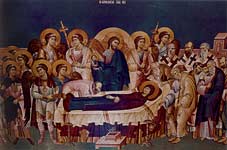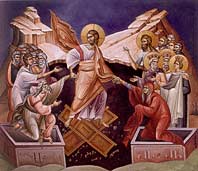|

The Icon of the Dormition (Falling asleep of the Theotokos)
commemorates the death, resurrection and glorification of Christ’s Mother. In the icon the
Theotokos is shown on the funeral bier. Christ, illuminated by the mandorla of divine glory,
looks down at His Mother as He prepares to receive her soul into Heaven. He holds her soul,
depicted as a babe wrapped in white garments, in His arms.
St. Peter, standing at the head of the bier, censes her body while St. Paul venerates her
body from the foot of the bier. They are surrounded by the other Apostles, miraculously
gathered from all over the world for the funeral. All of the Apostles are assembled for
the funeral except Thomas who arrives three days later. Wishing to venerate the Theotokos,
Thomas asks to see her for the last time. The tomb is found to be empty. Church tradition
relates she was bodily resurrected.
 Also shown are bishops in episcopal vestments reading the prayers for the funeral service.
In the background faithful women look on the scene. The posture of all the figures direct
attention to the Theotokos. Scores of angels surround Christ. Heaven, depicted as a
semicircle at the top of the icon, is shown with its Gates open to receive the blessed
soul of the Theotokos. Sometimes shown in the foreground is a man whose hands have been
severed by an angel. He attempted to disrupt the procession carrying the body of the
Theotokos to the site of her tomb near Gethsemane. Tradition tells that he was later healed.
The Icon of the Dormition is one of the Apocryphal icons of the life of the Theotokos. These
icons are based upon the writings of the Church Fathers as contrasted with icons based upon
the Gospel writings of the Evangelists. Also shown are bishops in episcopal vestments reading the prayers for the funeral service.
In the background faithful women look on the scene. The posture of all the figures direct
attention to the Theotokos. Scores of angels surround Christ. Heaven, depicted as a
semicircle at the top of the icon, is shown with its Gates open to receive the blessed
soul of the Theotokos. Sometimes shown in the foreground is a man whose hands have been
severed by an angel. He attempted to disrupt the procession carrying the body of the
Theotokos to the site of her tomb near Gethsemane. Tradition tells that he was later healed.
The Icon of the Dormition is one of the Apocryphal icons of the life of the Theotokos. These
icons are based upon the writings of the Church Fathers as contrasted with icons based upon
the Gospel writings of the Evangelists.
The Icon of the Resurrection or “Descent into Hell'' depicts the most sacred event of
Christianity. The icon of Easter gives a powerful visual presentation and concise
theological illustration of the essence of Orthodox religion and faith.
In the icon Christ is majestically depicted in gleaming robes of white and
gold encircled by a full body nimbus radiating His Risen Glory. He stands boldly
astride the broken Gates of Hell. The locks and chains of death and sin, broken by
the presence of God's grace and love, fill the black void below Him. An old man tied
with ropes, the Evil One, may be shown.
 Christ is pulling Adam and Eve from their tombs, bestowing life to them and to all
righteous souls. As the Forerunner of Christ in Hades, St. John the Baptist is
always shown. St. John the Baptist has a halo while Adam and Eve do not. Also pictured
are important personages of the Old Testament. Texts identify them as Kings David and
Solomon, young Abel and Prophets of the Old Testament. Christ is pulling Adam and Eve from their tombs, bestowing life to them and to all
righteous souls. As the Forerunner of Christ in Hades, St. John the Baptist is
always shown. St. John the Baptist has a halo while Adam and Eve do not. Also pictured
are important personages of the Old Testament. Texts identify them as Kings David and
Solomon, young Abel and Prophets of the Old Testament.
The Resurrection icon is a stunning example of theology in color. It is the visual counterpart
to the joyous hymn sung at the Anastasi or
Easter Resurrection Service and for the
forty days following Easter. All Orthodox joyously proclaim, Christ is Risen from the dead, trampling
down death by death and giving life to those in the tombs.”
Other depictions of the Resurrection include icons of The Myrrh-bearing Women, the Empty Tomb,
and St. Thomas touching the nail and lance wounds of Christ.
Iconographers must depict events integral to the Resurrection, but not the Resurrection itself.
Because the Resurrection was never described in Sacred writings of the Gospels or Church Fathers,
images of the physical Resurrection of Christ are not shown in icons. This follows the basic tenet
of iconography, that all icons must be based on writings of the Gospels and Church fathers.
(Written
by Faye Peponis, who has served the Greek
Orthodox Church for over 35 years in various
administrative and teaching capacities. She
holds a Bachelor's Degree in Education from
DePaul University and a Master's in
Education from Purdue University.)
Click here to return to August newsletter
Excerpts and Photography
from
Ecclesia: Greek Orthodox Churches
of the Chicago Metropolis
by Panos Fiorentinos
|

